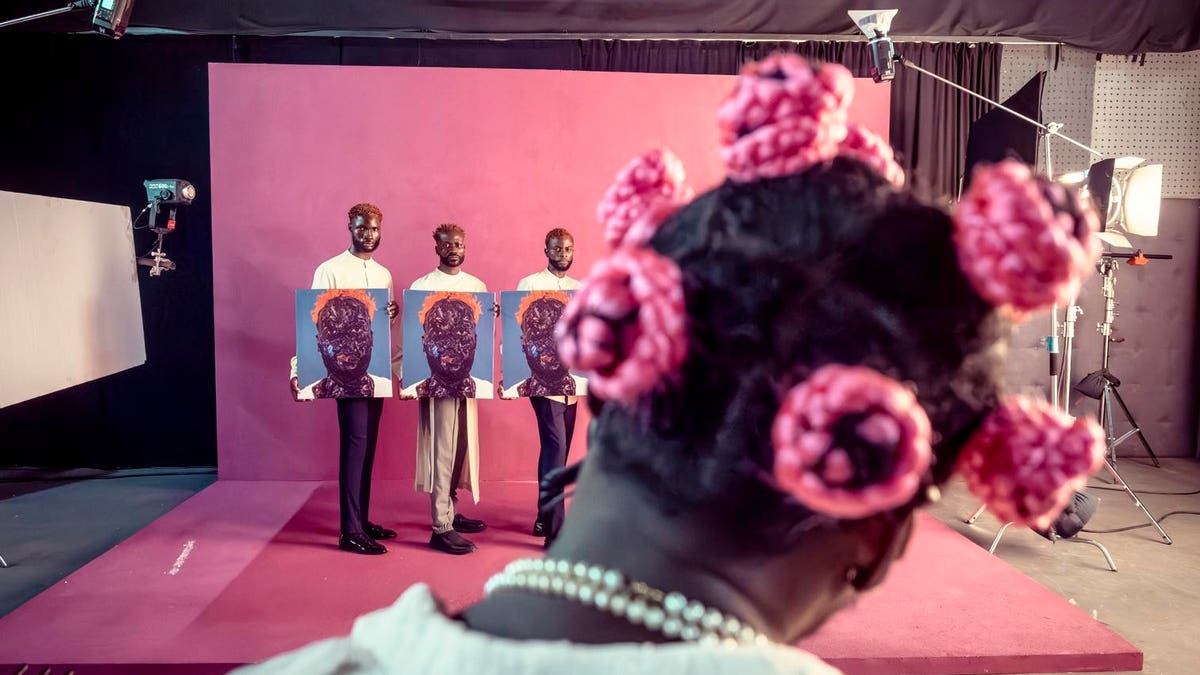Formerly infamous for its ‘soft-porn for the C-suite’ salaciousness – brand-sanctioned girlie calendars largely from and for a distinctly heteronormative male gaze – Italian tyre brand Pirelli has long had a job on its hands to keep the undoubtedly coveted ‘Cal’ relevant for an irrevocably changed cultural mood.
Not only does the 50th edition/60th anniversary of the art project jettison anachronistic erotica (including now-laughable product placement – see Uwe Ommer’s 1984 edition featuring tyre tracks on nude sun-kissed bums) but it also ditches its formula for using iconic fashion photographers to parlay style magazine aspiration into art. Enter: 28-year-old Ghanaian visual artist Prince Gyasi, the first Black creative to shoot it, and its most radical reinvention yet.
Next Level Reinvention
It’s not Pirelli’s first crack at reincarnation. The 2016 edition, artfully shot by Annie Leibowitz, who also commanded the millennium creative, bore an impressive cast of high-profile feminists including Yoko Ono, Patti Smith, Serena Williams, Fran Lebowitz, Amy Schumer, and Tavi Gevinson (once referred to as ‘Girl Power’s Last Hope’). Steven Meisel’s 2015 iteration had its second plus-sized model in Candice Huffine (following Herb Ritts’ Sophie Dahl in 1999) but the creative premise of “sensuous beauty” and litany of baby-doll bombshells delivered a less than convincing manifesto for a brave new female (or anyone’s) future. In 2023, Australian Emma Summerton foregrounded her own female muses in a whirl of her signature magical realism.
Here, for the first time it’s stepped beyond a Western-centric gaze into a space where, almost unthinkably, the most-talked about advances aren’t fixated on the body. From a shift towards ‘intentional representation’ including a rejection of Black clichés to an Afro-centric vista that’s both on-the-pulse and prophetic, here’s why issue 50 may be a major benchmark.
The Shifting Axis of Youth Culture and the Gyasi Allure
Gyasi, one of the calendar’s youngest image-makers to date, represents a new generation of extraordinary African talent with a global fanbase (his main home is in Accra but he travels extensively) and counternarratives to the prevailing Western perceptions of Africa. “I think they [Pirelli] wanted someone to bring a new dimension to their realm, someone contemporary and intellectual but playful at the same time… and young” says Gyasi.
When it comes to fuelling the publicity machine youth always matters and Gyasi presents a thrilling line to a continent widely touted as the new epicentre of youth culture as the tectonics of pop culture shift: over half of the global population growth between now and 2050 is expected to occur in Africa, and by 2100 the number of Africans aged 15-24 is projected to reach half a billion (UN, 2022). As the rest of the world ages, Africa’s youth will be firmly in the ascendent.
But far from an invite to tap trends as only a white-hot young artist legitimately can, Gyasi, who is supported in the project by Olaoluwa Ebiti among others (a UK-based stylist with Nigerian and Yoruba heritage, renowned for exploring nuanced shades of masculinity) views it is a responsibility to transcend the zeitgeist: “I’ve always been very aware of wanting to create a body of work [with this calendar] that would live forever – of representing the moment while creating something with the timelessness and longevity to inspire other generations.”
Afro-Surrealism and Stories of Solutions
Timelessness is the official theme for 2014, a focus well-aligned with the dreamlike, chronology-morphing, Afro-surrealist aspects of Gyasi’s work (Afro-surrealism being described by D. Scot Miller, writer, and author of the Afro-surrealist manifesto, as a movement that ‘presupposes that beyond this visible world there is an invisible world striving to manifest, and it is our job to uncover it’).
Echoing the recent sentiments of British non-fiction author Emma Dabiri (“I write for the world as it could be, for us, as we could be, if our worldview was holistic”) Gyasi states: “My work is about the present and the future but to create a [more positive] future you have to go into the past – to see and understand what it is that you want to change. Pirelli really gave us a blank canvas to produce something where the next generation feel they can look forward to finding a solution.”
Jonathan A.J. Wilson, Professor of Brand Strategy & Culture at Regent’s University London concurs: “Prince Gyasi’s work embodies the Afro-surrealist movement’s intentions of wanting to explore and reframe diasporic being, and identities, with hyperreal vibrancy [notably Gyasi’s has synaesthesia, a condition involving experiencing one sense via another, in his case with words summoning colour]. Representation is so, so important, but achieving that sweet spot of authenticity and credibility weighs heavy on the shoulders of so many who try.”
Seemingly fine with the hefty expectations, Gyasi’s all-star cast of Black talent, which includes film director Jeymes Samuel, painter Amaoko Boafo, footballer Marcel Desailly, model Naomi Campbell and actors Idris Elba and Angela Basset (“all people who created a blueprint for me of some sort, who have taken the roof right off the [glass] ceiling and without compromising”) are all about offering positive solutions.
For instance, Nigerian Afro-beats star Tiwa Savage stands in front of a giant love-heart, skewered by a shower of blue arrows. “That image is effectively about saying we [the Black community] have such a big heart that we can’t be crushed no matter how we may be attached; it’s the notion of love immersion; the solution to the problem is ultimately love.”
In another we see the trans-generational power duo of Margot Lee Shetterly (writer of the book Hidden Figures: The American Dream and the Untold Story of the Black Women Who Helped Win the Space Race) and poet Amanda Gorman in front of a blackboard bristling with equations. A paean to female strength and the power of education – the image actually references his existing (2021) artwork “The Power of Choice / The Choice of Power (TPOC / TCOP). “It’s about being disciplined in the face or possession of power,” explains the artist.
Beyond Objectification
Adriane Jefferson, founder of US PR agency DISRPT, applauds the latter image for its dismantling of TikTok-ified tropes: “Yes, there are some big names here, but the image that really struck me was the one with Shatterly and Gorman because it’s not just about #BlackJoy or #BlackGirlMagic [once positive phrases relating to Black excellence that have since slipped into cliché] but something more original, and regal. It provides a real sense that Black is not just a monolith.”
She continues; “Similarly, there’s the image of Naomi – a very different version of how we usually see her and particularly how she’s been depicted previously in the calendar [ 1987, 1995, 2005 and 2018] including at 16, shot by Terence Donovan, with her bottom out.” That year, incidentally, Donovan upped the nipple count to a whopping 26,
Another conceptual throwback, the image recalls Gyasi’s 2021 shoot with Campbell for Madame Figaro – an editorial shot in Lagos and styled by Jenke Ahmed-Tailly (a Parisian stylist/creative director born on the Ivory Coast who was responsible for a series of seminal Beyoncé shoots in 2011 in which the megastar explored her African roots). The stance loosely echoes the original image of her on a station platform, chased by kids. “There is a feeling with Naomi that’s she been around since the 18th century, constantly pursued by others. She almost breaks time,” reflects Gyasi.
Is there, I ask, a risk of these images inadvertently fuelling objectification? Art might legitimise the erotic but it certainly won’t erase the outrage caused from the contemporary replication of offensive tropes, “especially when the lauded attractiveness of blackness graces catwalks, photoshoots, and adverts, but does not permeate into everyday life and the workplace where people still face discrimination,” remarks Wilson.
“It’s true that the objectification of Black women, and also men, has been going on for centuries. Just look at the Kim Kardashian cover for Paper magazine,” says Jefferson, referencing the shot in which Kardashian poses with a champagne glass perched on her distended backside – a recreation of art director Jean-Paul Goude’s hyperbolised (illusory) image of Carolina Beaumont for his 1983 book Jungle Fever, which itself may have referenced South African Saartjie Baartman, a woman brought to London in the 19th century as a sideshow curiosity.
“But what’s key here is that there’s a clearly a celebration of his [Gyasi’s] roots and own experience; the sense of wanting to truly connect with the Black community. The visual naivety present in the work also provides a more enabling sense of exploration.”
Shooting the Establishment: From Self-Portraits to Royalty
In another first for the calendar, Gyasi enlisted Ghanaian royalty with King Otumfuo Oseo Tutu II, following original ambitions to manoeuvre politics into the mix (Pirelli isn’t quite yet ready to take brand activism beyond a non-partisan stance). It took four months to get him board. “To shoot him outside of his palace, to not be sat on the throne [as is the regular protocol], but in a set that I’d design was absolutely unprecedented. I’ve been watching this man since I was a child.”
It’s also the first time that the calendar has included a self-portrait of the photographer, in this instance accompanied by a miniature Gyasi, a reminder of both how these people inspired his younger self and the importance of attending to legacy.
Distribution Democratisation?
Internet virality aside, will ambitions to not only seduce the creative and commercial elite but also capture the imaginations of disenfranchised youth be possible when the physical product rarely gets seen at grass roots? The exclusivity of the calendar itself may be rising – around a decade ago it was reported that the print run had decreased from 50,000 to 25,000, which may this year be closer to 12,000. However, Gyasi reveals that he will potentially be able to stake a claim to where 50% go. “Everything about where it goes, and how it’s packaged, will be different. Community is key, I want everyone to see it.”
What’s Next?
The Pirelli team are tight-lipped about what comes next but who would Gyasi himself champion given the chance? “A painter I think… yes, a painter.”
Read the full article here





